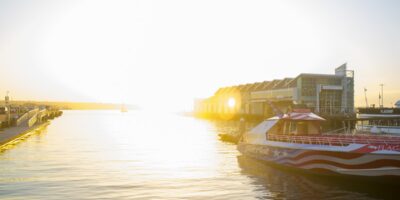Pilar Boat: An Icon of the Sea
The Pilar boat holds a unique place in maritime history, famous for its connection to the renowned writer Ernest Hemingway. Commissioned in 1934, the Pilar was a Wheeler Playmate, a type of cabin cruiser designed for both leisure and sportfishing. Hemingway’s adventures aboard this vessel have left an indelible mark on both literary and fishing communities.

Specifications and Design
The Pilar was a 38-foot boat built from cedar planks over oak frames by the Wheeler Shipyard in Brooklyn, New York. It was powered by a dual propulsion system, consisting of a 75-horsepower Chrysler straight six-cylinder gasoline engine and an additional smaller auxiliary motor for trolling. This combination made the Pilar versatile, capable of both speed and maneuverability.
Equipped with a fighting chair, outriggers, and a large cockpit, the Pilar was perfectly tailored for deep-sea fishing. The addition of a flying bridge gave Hemingway a superior vantage point for spotting fish in the crystal-clear waters of the Gulf Stream.
Ernest Hemingway’s Influence
Hemingway was more than just an owner; he was an active participant in the design and modifications of the Pilar. His influence is evident in the custom features such as the wooden roller for landing fish, designed to prevent the fishing line from fraying.
Hemingway’s passion for fishing led him to innovate techniques and equipment. His observations and experiences on the Pilar informed much of his writing, including the famous novella The Old Man and the Sea. His detailed records of catches, weather conditions, and nautical logs have served as valuable historical documents.
Adventures on the Pilar
Hemingway used the Pilar not just for leisure, but for various exciting escapades. During World War II, he turned the vessel into a patrol boat, participating in clandestine operations to spot enemy submarines in the Caribbean. His exploits during this period are a testament to his adventurous spirit.
Fishing was, however, the primary use of the Pilar. Hemingway and his crew made many notable catches, including marlins, sailfish, and tuna. Miles from shore, the Pilar often ventured into the Gulf Stream, where Hemingway honed his skills and deepened his appreciation for the sport.
Legacy and Preservation
The Pilar’s legacy extends beyond its physical form. It has become a symbol of adventure, craftsmanship, and the unyielding spirit of exploration. After Hemingway’s death, the boat was preserved and now resides at Finca Vigía, Hemingway’s home in Cuba, which is a museum today.
Marine preservationists have studied the Pilar extensively. Its design offers insights into the evolution of sportfishing boats. Its preservation provides a tangible link to Hemingway’s life and work, attracting scholars and enthusiasts worldwide.
Relevance in Popular Culture
The Pilar has made appearances in various forms of media. It has been featured in documentaries, books, and TV shows that explore Hemingway’s life. The boat represents a period in time marked by adventure and cultural change.
Notably, modern replicas of the Pilar have been built by enthusiasts and historians. These meticulous reconstructions pay homage to the original and allow new generations to experience a piece of maritime history.
Technical Aspects for Enthusiasts
- Length: 38 feet
- Beam: 12 feet
- Draft: 3 feet
- Engine: 75-hp Chrysler plus auxiliary kicker
- Hull Material: Cedar planking over oak framing
Understanding the technical aspects of the Pilar can provide deeper appreciation for its capabilities. The design choices made in the construction reflect the double duty of leisure and functional fishing support. The balance between lightweight cedar and durable oak ensured both speed and resilience.
The flying bridge allowed for better visual scanning of the waters, an innovation for its time. The fighting chair and customized landing roller exemplify Hemingway’s hands-on approach and quest for efficiency.
Cultural Impact
The Pilar influences not only maritime circles but also literary and cultural realms. Hemingway’s connection to the boat has posthumously enhanced its celebrity status. Fans of his work often regard the Pilar as a physical manifestation of his adventures, ideologies, and zest for life.
Its preservation at Finca Vigía serves as a pilgrimage site for those seeking to delve into Hemingway’s world. The boat remains a silent observer to the legacy of one of America’s greatest writers.
Modern Day Pilar
Today, the Pilar continues to inspire. The comparisons between vintage craftsmanship and modern boat-building practices highlight changes in materials, technology, and design philosophies. Enthusiasts and historians alike study the Pilar to appreciate these evolutions.
Replicas and restorations of similar boats keep the essence of the Pilar alive on modern waters. They serve as functional tributes to an era of hands-on exploration and personal connection to the sea.
Interactive Opportunities
For those interested in experiencing the Pilar (or its replicas), many museums and historical societies offer guided tours, exhibitions, and interactive sessions. These opportunities provide a closer look at the boat’s construction, Hemingway’s modifications, and stories of the numerous expeditions it undertook.
Learning about the Pilar’s journey from a simple fishing vessel to a cultural icon can offer insights into the intersection of history, technology, and personal ambition.
“`




Subscribe for Updates
Get the latest articles delivered to your inbox.
We respect your privacy. Unsubscribe anytime.